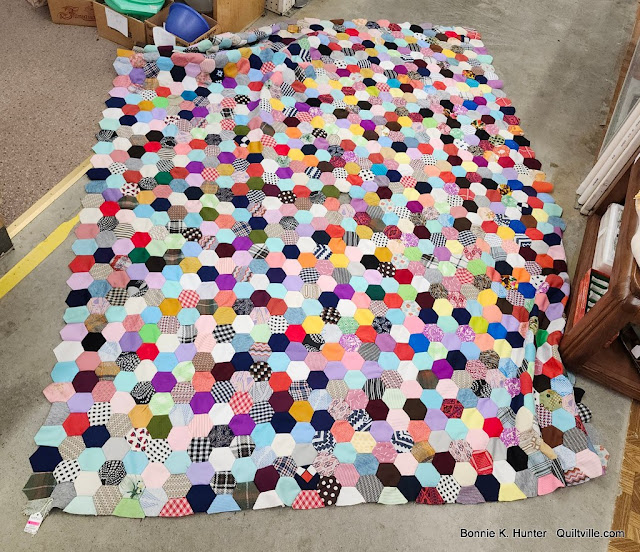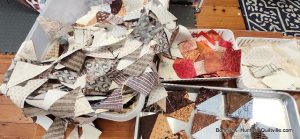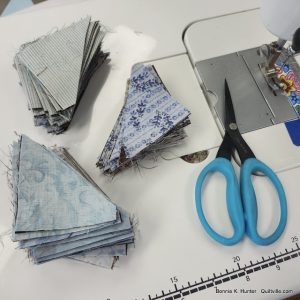How long has it been since I had an antiquing day with a friend including lunch out?
October if I remember correctly – way too long!
But the way things are, sometimes you have to choose different haunts, and give the merch time to turn over so there is new stuff to browse – right?
Up on deck for Saturday was anything with a sewing nature, be it quilts, tops, blocks, sewing notions and machines.
And of course – we are always on the lookout for the weird thing of the day.
Polyester double knit hexie – hand pieced!
Double knit is one of those 1960s-1970s miracles of manufacturing which thankfully was not long-lived.
What middle aged woman going through any change of life wanted to drape her entire body in heavy weight double knit which basically boils down to as a “petroleum product?”
This stuff will NEVER wear out. It also doesn’t ravel, which probably was touted as one of its positives – especially before home-owned sergers were a mainstay in the sewing room of any garment sewist.
But talk about HOT? And HEAVY? Definitely not breathable….and oh, baby – the stretch!
Same with this one –
Same maker, maybe?
The colors and patterns are adorable, but sleeping under this thing is going to be hotter than a hotel duvet in the Australian Outback, and I’ve been there, done that!
There’s something fun about the checks, houndstooth and prints, though.
Baby coverlet? Maybe?
Acrylic yarn fringe?
Great grandma loved to quilt. Her piecing was really nice. But there is also no way to actually PRESS a double-knit seam and get anything to lay flat.
I can’t imagine trying to hand quilt through a double-knit top + batting + backing – so maybe just calling it good with yarn fringe is an okay idea?
My heart did a little flip-flop and smile when I saw that she started with a plan and evidently ran out of the dark brown she was using as a background…had to go with the plaid to get the job done.
The substitutions made to keep things going are the little bits that I find charming in vintage quilts, and perhaps someday someone will get a little smile seeing where I’ve done that, too.
1950s – 1960s Improved Nine-Patch.
Lots of these blocks have substitutions!
The maker just kept on going no matter what fabric they had in the scrap bag.
Sweet dresden top.
Several of the blocks are the same – but the maker must have ran short and went other directions to pull some variety in and get the top big enough.
Chambray and plaid. Wonderful!
This was my favorite block –
That black and white print looks modern, doesn’t it? Combined with two different strips and a boxy print that could well be pajamas or boxer shorts. But it’s so pleasing over all.
Heavy, heavy Cathedral Window.
Up close –
Traditionally these are all hand stitched and use gobs of yards of background fabric.
This one looks machine stitched and possibly 1980s or 1990s fabrics?
Amish made, beautiful hand quilted –
There was a time in my life where I would have snatched this up, but I am at saturation level and left it for someone else to enjoy.
The hand quilting stitches are MINISCULE. So tiny. The batting is poly.
Spool cabinet desk –
Way too pricey –
I had one of these, but they are hard to display as the tops are slanted so you can’t put a lamp on top of them…it makes a not quite horizontal surface that is hard to make useful unless you ARE using it as a desk.
One lone treadle –
And yes, we moved some stuff, opened the lid and freed the machine!
Such a pretty one! And I’ll never understand how a vendor is supposed to encourage anyone to buy the machine if it is all closed up with a bunch of stuff piled on top of the cabinet.
Sweet girl even has her shuttle!
Oh my word! A Veg-O-Matic! LOL!
When we were first married in 1981 I found one of these at a yard sale on the cheap. I thought it was the bee’s knees at the time. It sliced and diced potatoes so quickly – And I used it for cutting cucumbers to make pickles, etc.
Eventually the springs in the top gave out and it wouldn’t plunge or pop up anymore.
This gave me a great giggle and memories from 40+ years ago.
Remember when EVERYTHING was a “Something-O-Matic?”
Needless to say, this did NOT come home with me.
My wedding Tupperware! LOL!
There is SO MUCH old Tupperware in antique malls now – it’s so funny! I did everything I could to finally get rid of this stuff, and now it’s collectible?
More peals of laughter. I do have some Tupperware that I still use – off the top of my head a huge canister with a lid that I keep sugar in.
Weird thing of the day –
Not really weird at all if you are from the Southeast. Face jugs are just a THING here.
These are evidently newer – but the prevalence of face jugs as an art form goes way back.
I find them fun the same way I find Jack-o-lantern carving creative and entertaining during Halloween season.
“Face jugs, a distinct type of American folk art, originated in the South, particularly the Edgefield District of South Carolina, during the mid-19th century, as pottery created by African American slaves and freedmen. These jugs feature grotesque, often exaggerated faces, and their production and use are shrouded in mystery, with various theories about their purpose ranging from ritualistic objects to graveyards to containers for moonshine.”
Key aspects of the history of face jugs:
Origin:
The tradition of face jugs began with African American potters in the Edgefield District of South Carolina, where a large stoneware industry flourished.
Materials:
The jugs are made of stoneware, a type of clay, with facial features often made of kaolin, a white silica clay, which was also used in West Africa.
Possible Purposes:
Ritual and Spiritual: Some scholars believe face jugs were used in African religious and spiritual practices, possibly as containers for magical materials or as part of ceremonies.
Grave Markers: Since enslaved people were often denied tombstones, some theories suggest face jugs served as alternative grave markers, with the “ugly” faces meant to ward off evil spirits.
Protection and Fear: The exaggerated features were also thought to be a form of protection, scaring away evil spirits or, in later times, children from drinking moonshine.
Utility: Face jugs may have also served a functional purpose, holding water, food, or other items.
White Pottery Influence:
Around 1880, white potters began to adopt the face jug design, often using different materials and producing them as whimsical items.
Continued Tradition:
The tradition of face jugs continues today, with contemporary potters continuing to create these unique vessels, drawing inspiration from the original designs.






























